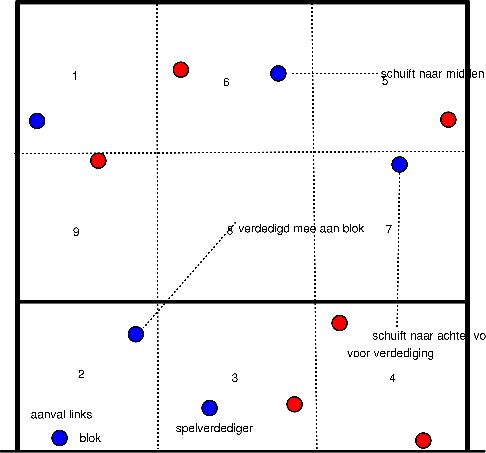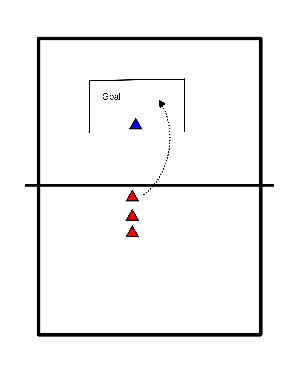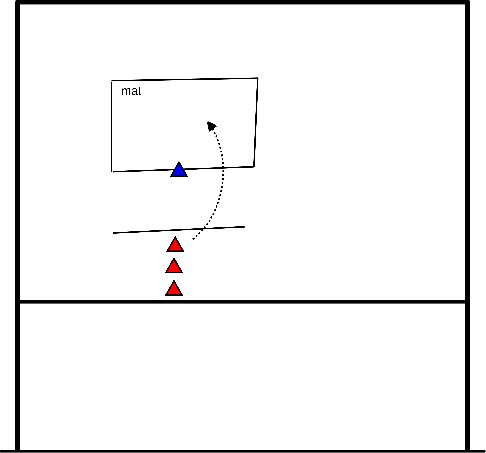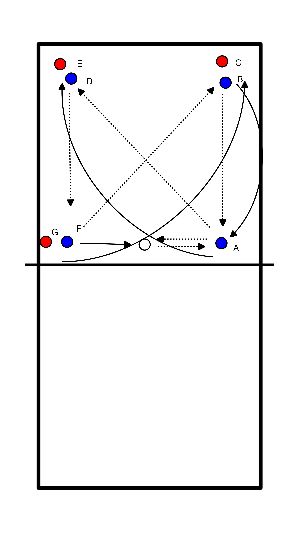Volleyball drills for technique general
- Leg swing 20x forward left and right
- Leg swing 20x sideways left and right
- Lunge with twist: Big step forward, good to the ground, and rotate trunk to left and right 20x
- Plank: 30 sec
- Side plank: both 30 sec
- 15 sit-ups both sides
- 15 push-ups
- 10 burpees
- Stomp, slowly build up to 100% and loose to sprint
Form pairs,
- Each pair has 2 tennis balls and holds the tennis balls with outstretched arms
- The other player stands opposite, with his hands above the hands of the person with the tennis ball
- The person with the tennis ball drops one of the tennis balls, while the other person tries to catch it before it hits the ground.
- Often the volleyball field is divided into six positions, you can also divide the field into nine sections of three by three meters.
- This can be of value in coaching, service and (tactical) attack.
- I let the group hold hands and then call a number below ten.
- The group must then move as quickly as possible to the appropriate section.
- Tip: After practicing this, I call out a number under ten at practice and have players point to the appropriate section on the court.

Arrangement of equipment:
- The trainer stands with a large ball ready in his hands.
- The players all hold a regular volleyball.
Course of play:
- The players throw their ball to the trainer.
- The trainer lets the ball bounce on his big air ball.
- The ball will bounce to different sides, the children try to catch the ball.

set up of equipment:
- Goal in the middle of the field, with someone in it
- Other players on the other side of the net.
Course of play:
- The players throw/strike the ball towards the goal and try to score in the goal.
- The player in the goal (blue) tries to keep the balls out of the goal.
Remark:
Set the net as low as possible.

Arrangement of material:
- Mat against a wall
- Player 1 (blue) near the mat
- Other players (red), behind a certain line (depends on players)
Game flow:
- The players behind the line throw the ball to the mat
- Player 1 tries to keep the ball from the mat, he can do this with various movements.
As soon as one of the players touches the mat, they may take a marker from Player 1.
If Player 1 has no more marker disc, he loses and another player may take it. (number to choose, for example 5)

- Players play two against two.
- Each time the ball is over, they walk over to the other side of the net and join in behind.
- The goal is to keep the ball in play as long as possible.
- If a team makes a mistake, they have to dive to the other side.
- Often the volleyball field is divided into six positions, you can also divide the field into nine sections of three by three meters.
- This can be of value in coaching, service and (tactical) attack.
- I let the group hold hands and then call a number below ten.
- The group must then move as quickly as possible to the appropriate section.
- Tip: After practicing this, I call out a number under ten at practice and have players point to the appropriate section on the court.


Supplies: A stick about 2.5 meters long and 1 to 2 cm thick.
- The group gets the assignment to put the stick on the ground but it has to stay horizontal.
- The group stands up straight (see drawing) and stretches both forefingers to the front at shoulder width and the upper and lower arms are at an angle of 90 degrees.
- The trainer places the bar on the forefingers pointing forward.
- From this position, the group should try to bring the bar down to the ground.
- The bar must remain horizontal and not be raised or lowered on any side.
- The bar should not be grabbed either!
- Individual exercise to improve ball feeling with one hand.
- Each player has 1 volleyball, mini volleyball, tennis ball, juggling ball (or for advanced players a non round object; a light plastic container or light bottle for example, but can be used with anything).
- The goal of the players is to keep the ball in the air by hitting it as many times as possible with only one hand.
- Have the players count how many times they can do this per the 2 minutes per task.
- Possible assignments:
- - Underhand lobsmash
- - Over your head
- - Hit your leg afterwards with the hand you played with
- - Clap your hands after touching them
- - Lying down -> sitting -> standing (and back)
- - Raising your knee/heel
- - Against the wall
- - In pairs one player under, the other over the net=
Be creative! = - Possible exercise for several people. (see image)
- One or more in the middle, the rest around it.
- Setters play the ball somewhere around them, the rest have to make sure that the ball is returned to setters in X number of times.
- Agree on how many times the ball can be played.
- Exercise stimulates:
- - Communication
- - Reflexes
- - Ball sense

- F plays to B.
- B makes reception to A.
- A plays a short ball to F.
- F plays back and A plays the ball to D.
- D passes to G.
- G to A.
- A plays two short backs and G plays to C.

- Form several teams.
- Winning team can go under the net.
- Opposite team scores a point = stay put.
- Other team makes point ==> change at the other side of the net.







